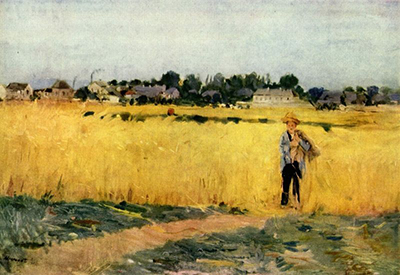Berthe Morisot's painting style was typically and consistently Impressionist. Her paintings highly made use of light and colours by achieving to paint images that were inspired by fleeting and shadowing techniques.
Location and Setting
The setting as depicted in the painting is of a small village of Gennevilliers, which is located just at the outskirts of Paris. This village has, however, grown to the suburbs of Paris. A closer look at the choice of her location and you will realise that it is typical of that which would have been chosen by any other Impressionist like Monet.
A closer look at the Berthe's painting and you would almost immediately realise that it you are presented with a visual composition that is so comfortable utilising three horizontal zones of colour. The painting is then punctuated by the figure of a young lad right at the foreground of the painting. Furthermore, the grain fields are an indication that area is a characteristic farmland for wheat since it mostly occupies the prime areas of the masterpiece.
Technique and Approach
Berthe utilises her intricately loose brushworks to depict the ears of the wheat and uniquely renders the structures in the background of the painting to be slightly sharper in detail than you might have expected. The use of sharper detailing makes it possible to perceive the smokestacks in the background from the sooty factories. This is a depiction of the transition of the area from agrarian era to an era to an industrial era leading to the slow disappearance of the small village, a virginal rural past. The delicate brushworks help the viewer perceive the impending change facing the village transitioning to a modern future.
Her brush techniques and style are consistently disjointed, full of light and bright colours that helps her able to represent the natural light on the grain fields by applying a large range of colours on the medium with almost petite brushworks. This helped her creatively render the painting in a very seductive representation of the small village experiencing a subtle protest against the transformation to a more modern way of life. This approach is significantly popularly among many other French painters, be it Post-Impressionists or Realists.
Influences and Inspirations
Berthe's painting style was highly inspired by Realism plus the inspiration from a number of great names in the industry. Such names include Auguste Rodin, Jean-Honore Fragonard, Edgar Degas and Jean-Baptiste-Camille Corot among other great influences that played a pivotal role in how she made use of her disjointed brushstrokes. However, a number of artist also found great inspiration from her works and some of the artists her work and style influenced include Eva Gonzalès and Mary Cassatt among other artists including the styles of Pointillism, Impressionism and Post-Impressionism.




